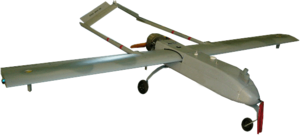- Class III UAV
-
AAI RQ-7 Shadow 
Grafik einer RQ-7B „Shadow 200“Typ: Taktische Aufklärungsdrohne Entwurfsland:  Vereinigte Staaten
Vereinigte StaatenHersteller: AAI Corporation Erstflug: 1991 Indienststellung: 2003 Produktionszeit: Seit 1999 in Serienproduktion Stückzahl: 322 (geplant) Die AAI RQ-7 Shadow ist eine taktische unbemannte Drohne, die für die Militärische Aufklärung bei Tag und Nacht von dem US-amerikanischen Hersteller AAI Corporation entwickelt und seit 1999 produziert wird.
Aufbau
Das Aufklärungssystem besteht aus dem unbemannten Fluggerät, einer modularen Nutzlast, einer Bodenstation sowie Start-, Rückhol- und Kommunikationsausrüstung. Das System umfasst ferner Versorgungsgüter und Ersatzteile für eine 72-stündige Mission. Zum Transport werden je zwei HMMWVs für Ausrüstung und Personal verwendet.
Eine Aufklärungseinheit besteht aus drei Drohnen und einem Ersatzgerät. Das leichte Fluggerät besteht aus Verbundwerkstoff, hat eine Spannweite von 3,9 m und eine Länge von 3,4 m. Das Triebwerk besteht aus einem handelsüblichen, benzingetriebenen Kreiskolbenmotor mit einer Leistung von 28 kW (38 PS). Die Nutzlast umfasst je eine optoelektronische und eine Thermografiekamera, die Flugsteuerung und die Kommunikationausrüstung zur Bildübermittlung. Die Navigation erfolgt über das satellitengestützte Global Positioning System. Die maximale Reichweite der Drohne ist durch den möglichen Verlust des Funkkontakts zur Bodenstation begrenzt und beträgt 125 km.
Technische Daten
- Primäres Einsatzgebiet: Taktische Bodenaufklärung
- Hersteller: AAI Corporation
- Antrieb: UAV Engines AR741
- Länge: 3,4 m
- Höhe: 1 m
- Gewicht: 154 kg (betankt)
- Spannweite: 3,9 m
- Geschwindigkeit: 130 bis 200 km/h
- Reichweite: 50 km
- Maximale Einsatzzeit: 4 Std
- Dienstgipfelhöhe: 4,600 m
- Tankkapazität: 37 Liter Superbenzin
- Nutzlast: 27 kg
Weblinks
Q-Serie
R/MQ-1 Predator | RQ-2 Pioneer | RQ-3 DarkStar | RQ-4 Global Hawk | RQ-5 Hunter | RQ-6 Outrider | RQ-7 Shadow | MQ-8 Fire Scout | MQ-9 Reaper | CQ-10 Snowgoose | RQ-11 Raven | RQ-14 Dragon Eye | RQ-15 Neptune | RQ-16 T-Hawk | MQ-17 SpyHawkX-Serie
X-45 Spiral | X-46 | X-47 Pegasus | X-50 Dragonfly
Wikimedia Foundation.
